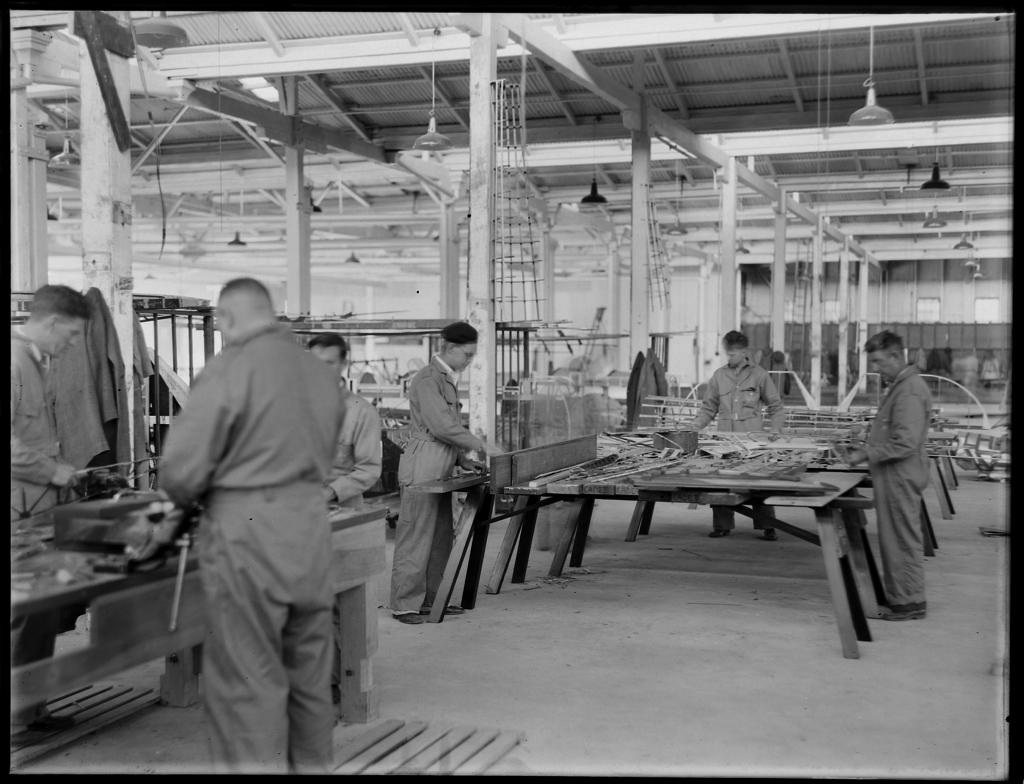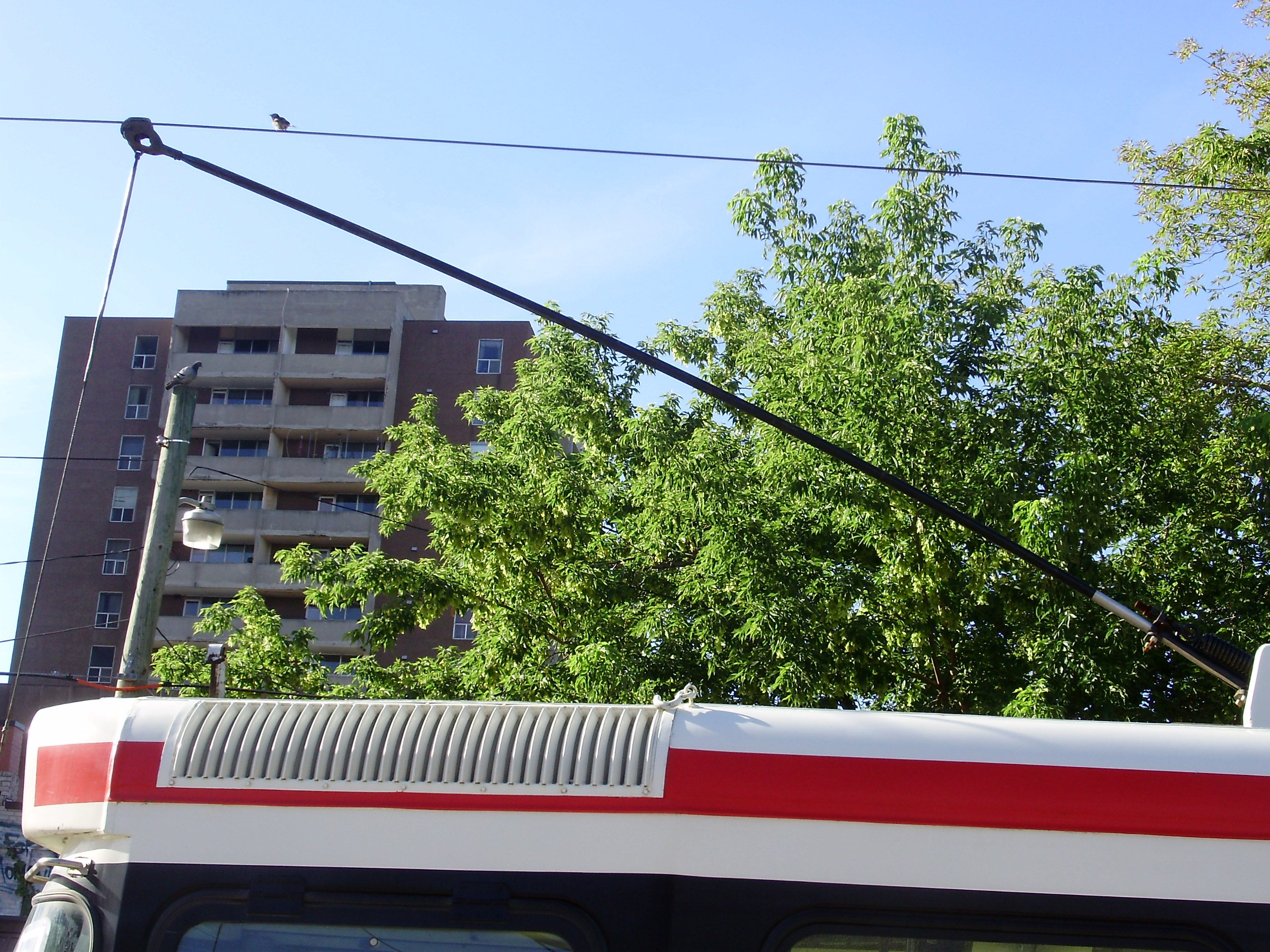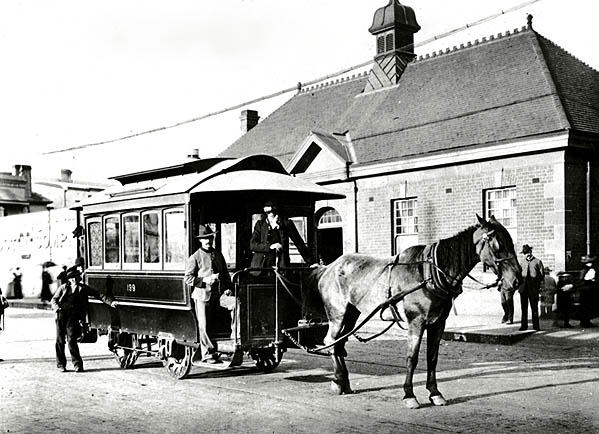|
Sydney E-Class Tram
The E-class trams were a class of single bogie (four-wheel) single-ended cross-bench design trams operated on the Sydney tram network. They always operated in permanently-coupled pairs because they were fitted-out electrically as if the pair was a single bogie car. History In 1901, two prototypes were built by the Randwick Tramway Workshops. Deemed a success, a further 200 were built by Clyde Engineering and Meadowbank Manufacturing Company in 1902/03. They were introduced for the electrification of the Eastern Suburbs lines, but also operated services on the North Shore lines. Withdrawals commenced in 1934; two pairs (499+500 and 529+530) were fitted with track brakes for the Neutral Bay service, with 529+530 lasting in service until 1955. Numbers *Randwick Tramway Workshops: (1901) 396, 397 *Clyde Engineering: (1902/03) 413-560, 611, 612 *Meadowbank Manufacturing Company: (1902/1903) 561-610 Preservation Two have been preserved: *529 & 530 at the Sydney Tramway Museum T ... [...More Info...] [...Related Items...] OR: [Wikipedia] [Google] [Baidu] |
Centennial Park, New South Wales
Centennial Park is a Suburbs and localities (Australia), suburb split between the Local government in Australia, local government area of the City of Sydney and the City of Randwick, located south-east of the Sydney central business district, in the Eastern Suburbs (Sydney), eastern suburbs of Sydney in the state of New South Wales, Australia. Centennial Park is home to a number of wild animals including birds, rabbits, and foxes. It is also home to a number of equestrian schools and other domestic animal endeavours such as the Centennial Park Rabbit Retreat, a boarding facility for rabbits in the Centennial Park and Paddington area. Geography The western fringe of the suburb is used for residential purposes and is within the City of Sydney. It features quality houses on large blocks as well as large multi-unit buildings. The bulk of the suburb consists of the Centennial Parklands (from which the suburb takes its name) and is within the City of Randwick. The parklands exte ... [...More Info...] [...Related Items...] OR: [Wikipedia] [Google] [Baidu] |
Randwick Bus Depot
Randwick Bus Depot is a bus depot in the Sydney suburb of Randwick operated by Transdev John Holland. History In 1881 the Randwick Tramway Workshops were established on the corner of Darley Road and King Street, Randwick as the main workshops for the Sydney tram network. It also had a depot attached. In 1902 the workshops were renamed the Randwick Tramway Workshops. The workshops grew rapidly to become one of Sydney's largest engineering establishments peaking in the 1920s. and performed all heavy maintenance on the fleet, Randwick Workshops were also instrumental for the construction of the L and LP classes that were completely rebuilt from the F class. O/P class, The PR and 2 of the PR1 classes were all converted by Randwick workshops out of trams that had been involved either in accidents or required major overhaul. During World War I and World War II workers from the Tramways Workshops were diverted to manufacturing armaments and artillery. The 1917 General Strike b ... [...More Info...] [...Related Items...] OR: [Wikipedia] [Google] [Baidu] |
Clyde Engineering
Clyde Engineering was an Australian manufacturer of locomotives, rolling stock, and other industrial products. It was founded in September 1898 by a syndicate of Sydney businessmen buying the Granville factory of timber merchants Hudson Brothers. The company won contracts for railway rolling stock, a sewerage system, trams and agricultural machinery. In 1907 it won its first contract for steam locomotives for the New South Wales Government Railways. By 1923 it had 2,200 employees. After contracting during the depression it became a major supplier of munitions during World War II. In 1950 it was awarded the first of many contracts for diesel locomotives by the Commonwealth Railways after it was appointed the Australian licensee for Electro-Motive Diesel products. Apart from building locomotives and rolling stock, Clyde Engineering diversified into telephone and industrial electronic equipment, machine tools, domestic aluminium ware, road making and earth making equipmen ... [...More Info...] [...Related Items...] OR: [Wikipedia] [Google] [Baidu] |
Meadowbank Manufacturing Company
Meadowbank Manufacturing Company was an Australian manufacturer in Meadowbank, New South Wales. History Mellor Brothers, a South Australian firm, established factories in Sydney (Meadowbank Manufacturing Co) and Melbourne (Braybrook Implement Co) in 1890 to manufacture agricultural equipment. Braybrook was taken over by Hugh Victor McKay in the early 1900s and that site became the Sunshine Harvester Works. The company purchased the 95 acre Isaac Shepherd "Helenie" estate on the Parramatta River adjacent to Meadowbank station. This property had plenty of timber, building stone and sand to construct the factory buildings, with enough left to sell to offset costs. The company purchased the Mellor patents for its stump jump plough. The company grew to be one of the largest engineering companies in New South Wales along with Clyde Engineering, Tulloch Limited and Ritchie Brothers. It was renowned for hiring and training many returned servicemen after the First World War. It was flo ... [...More Info...] [...Related Items...] OR: [Wikipedia] [Google] [Baidu] |
Trolley Pole
A trolley pole is a tapered cylindrical pole of wood or metal, used to transfer electricity from a "live" (electrified) overhead wire to the control and the electric traction motors of a tram or trolley bus. It is a type of current collector. The use of overhead wire in a system of current collection is reputed to be the 1880 invention of Frank J. Sprague, but the first working trolley pole was developed and demonstrated by Charles Van Depoele, in autumn 1885. Middleton, William D. (1967). ''The Time of the Trolley'', pp. 63–65, 67. Milwaukee: Kalmbach Publishing. . Etymology The term "trolley", also used to describe the pole or the passenger car using the trolley pole, is derived from the grooved conductive wheel attached to the end of the pole that "trolls" the overhead wire. The term "trolley" predates the invention of the trolley pole. The earliest electric cars did not use a pole, but rather a system in which each tramcar dragged behind it an overhead cable connected ... [...More Info...] [...Related Items...] OR: [Wikipedia] [Google] [Baidu] |
Volt
The volt (symbol: V) is the unit of electric potential, electric potential difference (voltage), and electromotive force in the International System of Units (SI). It is named after the Italian physicist Alessandro Volta (1745–1827). Definition One volt is defined as the electric potential between two points of a conducting wire when an electric current of one ampere dissipates one watt of power between those points. Equivalently, it is the potential difference between two points that will impart one joule of energy per coulomb of charge that passes through it. It can be expressed in terms of SI base units ( m, kg, second, s, and ampere, A) as : \text = \frac = \frac = \frac. It can also be expressed as amperes times ohms (current times resistance, Ohm's law), webers per second (magnetic flux per time), watts per ampere (power per current), or joules per coulomb (energy per charge), which is also equivalent to electronvolts per elementary charge: : \text = \tex ... [...More Info...] [...Related Items...] OR: [Wikipedia] [Google] [Baidu] |
Direct Current
Direct current (DC) is one-directional flow of electric charge. An electrochemical cell is a prime example of DC power. Direct current may flow through a conductor such as a wire, but can also flow through semiconductors, insulators, or even through a vacuum as in electron or ion beams. The electric current flows in a constant direction, distinguishing it from alternating current (AC). A term formerly used for this type of current was galvanic current. The abbreviations ''AC'' and ''DC'' are often used to mean simply ''alternating'' and ''direct'', as when they modify ''current'' or ''voltage''. Direct current may be converted from an alternating current supply by use of a rectifier, which contains electronic elements (usually) or electromechanical elements (historically) that allow current to flow only in one direction. Direct current may be converted into alternating current via an inverter. Direct current has many uses, from the charging of batteries to large power sup ... [...More Info...] [...Related Items...] OR: [Wikipedia] [Google] [Baidu] |
Overhead Line
An overhead line or overhead wire is an electrical cable that is used to transmit electrical energy to electric locomotives, trolleybuses or trams. It is known variously as: * Overhead catenary * Overhead contact system (OCS) * Overhead equipment (OHE) * Overhead line equipment (OLE or OHLE) * Overhead lines (OHL) * Overhead wiring (OHW) * Traction wire * Trolley wire This article follows the International Union of Railways in using the generic term ''overhead line''. An overhead line consists of one or more wires (or rails, particularly in tunnels) situated over rail tracks, raised to a high electrical potential by connection to feeder stations at regular intervals. The feeder stations are usually fed from a high-voltage electrical grid. Overview Electric trains that collect their current from overhead lines use a device such as a pantograph, bow collector or trolley pole. It presses against the underside of the lowest overhead wire, the contact wire. Current collectors ar ... [...More Info...] [...Related Items...] OR: [Wikipedia] [Google] [Baidu] |
Trams In Sydney
The Sydney tramway network served the inner suburbs of Sydney, Australia from 1879 until 1961. In its heyday, it was the largest in Australia, the second largest in the Commonwealth of Nations (after London), and one of the largest in the world. The network was heavily worked, with about 1,600 cars in service at any one time at its peak during the 1930s (cf. about 500 trams in Melbourne today). Patronage peaked in 1945 at 405 million passenger journeys. Its maximum street trackage totalled 291 km (181 miles) in 1923. History Early tramways Sydney's first tram was horse-drawn, running from the old Sydney railway station to Circular Quay along Pitt Street.''The 1861 Pitt Street Tramway and the Contemporary Horse Drawn Railway Proposals'' Wylie, R.F. Australian Railway Historical Society Bulletin, February, 1965 pp21-32 Built in 1861, the design was compromised by the desire to haul railway freight wagons along the line to supply city businesses and return cargo from the ... [...More Info...] [...Related Items...] OR: [Wikipedia] [Google] [Baidu] |
Neutral Bay Ferry Wharf
Neutral Bay ferry wharf is located on Neutral Bay on the northern side of Sydney Harbour serving the Sydney suburb of Neutral Bay. On 20 February 2012, the wharf closed for a rebuild. The existing wharf was demolished, with a new one built reopening on 20 August 2012. Wharves & services Neutral Bay wharf is served by Sydney Ferries Neutral Bay services operated by First Fleet class ferries. Interchanges Keolis Downer Northern Beaches Keolis Downer Northern Beaches is a bus operator in Sydney, Australia. A subsidiary of Keolis Downer, it operates services in Sydney Bus Region 8 on the Lower North Shore and Northern Beaches under contract to Transport for NSW. Its headquar ... operates one route to and from Neutral Bay wharf: *225: to Cremorne Point wharf References External links Neutral Bay Wharfat Transport for New South Wales (Archive12 June 2019Neutral Bay Local Area MapTransport for NSW {{Transport for New South Wales ferry wharves, Neutral Bay=y, state= ... [...More Info...] [...Related Items...] OR: [Wikipedia] [Google] [Baidu] |
Sydney Tramway Museum
The Sydney Tramway Museum (operated by the South Pacific Electric Railway) is Australia's oldest tramway museum and the largest in the southern hemisphere. It is located at Loftus, New South Wales, Loftus in the southern suburbs of Sydney. History Construction of the museum at its original site on the edge of the Royal National Park commenced in August 1956. It was officially opened in March 1965 by NSW Deputy Premier Pat Hills. The facilities were basic, initially a four-track shed built with second hand materials and approximately 800 metres of running track. In 1975, the Government of New South Wales approved the museum moving to a new site across the Princes Highway adjacent to Loftus railway station, Sydney, Loftus railway station. Construction commenced in April 1980, with the first trams transferred from the old site in November 1982. It officially opened on 19 March 1988. The former Railway Square tramway shelter that had been disassembled in 1973 was reassembled. The ... [...More Info...] [...Related Items...] OR: [Wikipedia] [Google] [Baidu] |




.jpg)

